Students get creative in the name of science
November 25, 2021
When Sir Isaac Newton formulated his law of gravity over 350 years ago after seeing an apple fall from a tree, he probably didn't envision raw eggs being tossed from a roof to validate his findings.
Nevertheless, for the last three decades at Plains High School, raw eggs have been sent to their doom in the name of science. The students of Carl Benson's physics class are learning Newton's Principia Mathematical Philosophiae Naturalis not with apples, but with their annual Egg Drop Project.
One by one last Tuesday morning, Paul Pickering, the school's maintenance supervisor, leaned over the edge of the gymnasium roof and dropped an egg in its protective casing to the pavement below. Making the egg survive is key, but this year, only two of the 14 students involved got bonus points for their egg landing without breaking. Senior Maddie Madden received the top honors and the extra 25 points for having the lightest contraption and an unbroken egg. Senior Aubrey Tulloch nabbed five additional points because her egg also survived, but it weighed 140.2 grams, which was 48.6 grams heavier than Madden's contraption.
The 17-year-old Madden spent about two hours on her final device, but she went a bit further than the other students even before erecting her graded apparatus. Benson gave each student the same materials for their protective casing: five marshmallows, six feet of yarn, six pipe cleaners, six rubber bands, six bamboo skewers, two balloons, and they could use glue. They were allowed to put air in the balloons, but no helium. Benson gave them a list of rules, including not using a chicken to hold the egg, which he said was to be humorous, but he added, "you can't bet on anything with kids."
They could use all or only a portion of the materials. All the materials, except for marshmallows, have been used before. "Kids are pretty creative when they do this, and it's fun to watch them come up with different things," said Benson, who added that it was them that convinced him to make one for his last class. He noticed that most of the devices did not slow down during the fall. He said the materials he picked this year didn't lend themselves to increasing wind resistance to slow their descent, which was why the velocities were similar.
Madden purchased the same materials on her own and ran tests at home. Her first three test flights were failures, ranging from about five feet to just over six feet. She did one that worked from about 10 feet standing on a big boulder and another from the house roof at around 25 feet high. She knew it wasn't as high as the gymnasium roof, which is around 49 feet, but she was confident the design she created would be a success. "I figured it would be going faster at the school, but I knew it would work," said Madden, who calculated that her device's velocity was 17.15 meters per second at the school.
Madden's device had a pyramid style skeleton made from the bamboo skewers and tied together with pipe cleaners. The egg was suspended in a cradle and wrapped in marshmallows and rubber bands. The balloons were inflated in an effort to create drag. The frame of the contraption was 11 1/2 inches wide and 9 1/2 inches tall.
The 16-year-old Tulloch's contraption was up seventh. None had survived and she was not as confident as Madden. She was a bit tense as her invention was sent to the sidewalk at 11.4 meters per second. But it was intact. Her egg was inside an deflated balloon, surrounded by marshmallows and encased with the skewers tied together with the pipe cleaners. It was suspended by yarn tied to an inflated balloon. The device alone weighed 88.4 grams.
The impacts varied. Some were obvious with yoke splattered across the pavement. For some, the sound of failure was distinct. Other apparatuses had to be taken apart to see the broken egg. Though the eggs of both Madden and Tulloch survived the crash, it was for different reasons, said Benson. Madden's egg withstood the impact because the structure she designed displaced the force with the legs bending. For Tulloch , it was because the egg was tightly wrapped and supported.
Benson's primary lesson was to get the students to understand the relationships between the physical laws of nature and how to apply those to everyday situations and to teach the students that an object in motion will stay in motion in a straight line unless some other type of force changes it. "The activity helps them visualize the application of Newton's Laws to a practical example. We use the egg because it is delicate and a lot of thought has to be employed to try and figure out how to save it," said Benson.
Most of the time for Benson's students, it's their own devices that act as that other force, but this year, the wind played a big part, which also took away the winning honor from Benson himself, who made a contraption for the second time since he instituted the project. With this being his last year at Plains High School, Benson had hoped to have his egg unscathed. Twice, while trying to insert eggs into the balloon earlier in the week, they shot out and hit the floor. His was by far the lightest device - weighing in at 70.8 grams - 11.4 grams without the egg. "I was definitely going for the win," Benson said. He added that the project brings out the competition in the students, but he believes they were more competitive against him this time.
"You guys beat the teacher - way to go," said Pickering. The gathering of students on the ground - and perhaps some teachers - cheered when Benson's device struck the sidewalk. Pickering hoisted each device individually in a bucket. Students told him how to hold their device for the release, except Connor Burnham, who said he didn't care and whose 93.7-gram project traveled at 13.4 meters a second and visibly splattered on the cement on impact.
Benson started teaching at Plains High School 38 years ago. He's seen some strange apparatuses over the years. One student's device was made entirely of rubber bands and another used just marshmallows. Both survived. He admitted that this year was more difficult because of the materials he selected. The eight girls and three boys, all seniors, began working on their projects three weeks ago, making the casings during the 50-minute class time. The students put several hours into their projects and even though they all had the same materials to work with, finished products varied.
Jolena Caldwell was one of the first finished and was one of the heaviest devices at 142.8 grams completed and 81 grams without the egg inside. Wrapped in only deflated balloons and marshmallows, she calculated it traveled at 11.9 meters per second. Kaylah Standeford also protected hers with packed marshmallows inside balloons. It weighed 130.6 grams with the egg, but was determined to be going at 15.9 meters a second. Adelle Ercanbrack inserted hers into a balloon, but placed it into an oblong type stick frame. The entire package weighed 123 grams, nearly double of the egg alone, and she figured it was going at a velocity of 12 meters a second.
Grace Horton and Madison Elliot looked like their balloon-wrapped eggs were protected by a stick box. Elliott's device with the enclosed egg was 89.3 grams and was calculated at 13.9 meters per second. Horton's completed contraption was the second heaviest at 164.5 grams and went 11.3 meters per second.
Krystena Boles' finished package, a partially inflated balloon wrapped with skewers and pipe cleaners, was the heaviest of the class at 206 grams. Moving toward the sidewalk at 10.4 meters a second, it provided the crowd with a big splattering of egg and structure parts on the pavement. Lexa Craft's design resembled a house frame with her egg inside a deflated balloon, weighing 107.6 grams and moving at 12.05 meters per second. The remaining students, Gabe Worrall, had not turned in his calculations, and Dawson Brown, was absent on drop day.
"I thought they did well, using a lot of creativity. Maddie's was amazing in how she bent the legs to absorb the shock," said Benson, who has two more building projects in store for the class before he retires in June. Benson has changed the materials over the years, but he thinks this might have been one of the toughest. This was the lowest number of egg survivors he's had in six years. He's never had a class where none have made it. "This lets them see that all things are affected the same way by gravity and with the materials that I gave them, it will be very difficult to build an apparatus that has enough resistance to slow it down," said Benson. He believes that having a fun with the visual project helps them learn and remember the material and the practical exercise helps students understand the concepts. He said he could tell the plan works because as a whole students' grades increased. But not every aspect of the project is fun. The students still have to take a test with problem solving situations.
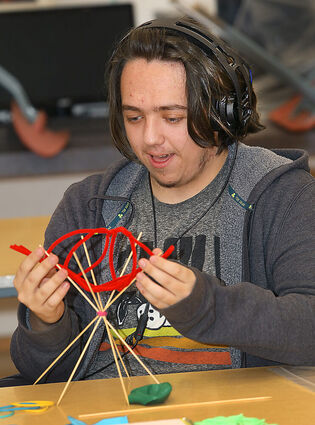
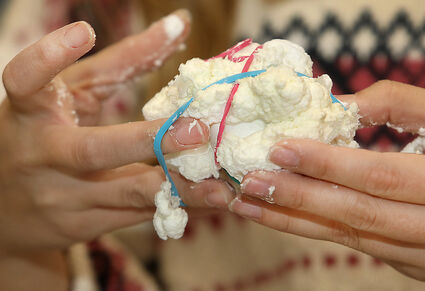
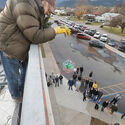
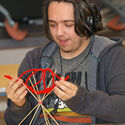
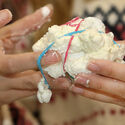







Reader Comments(0)